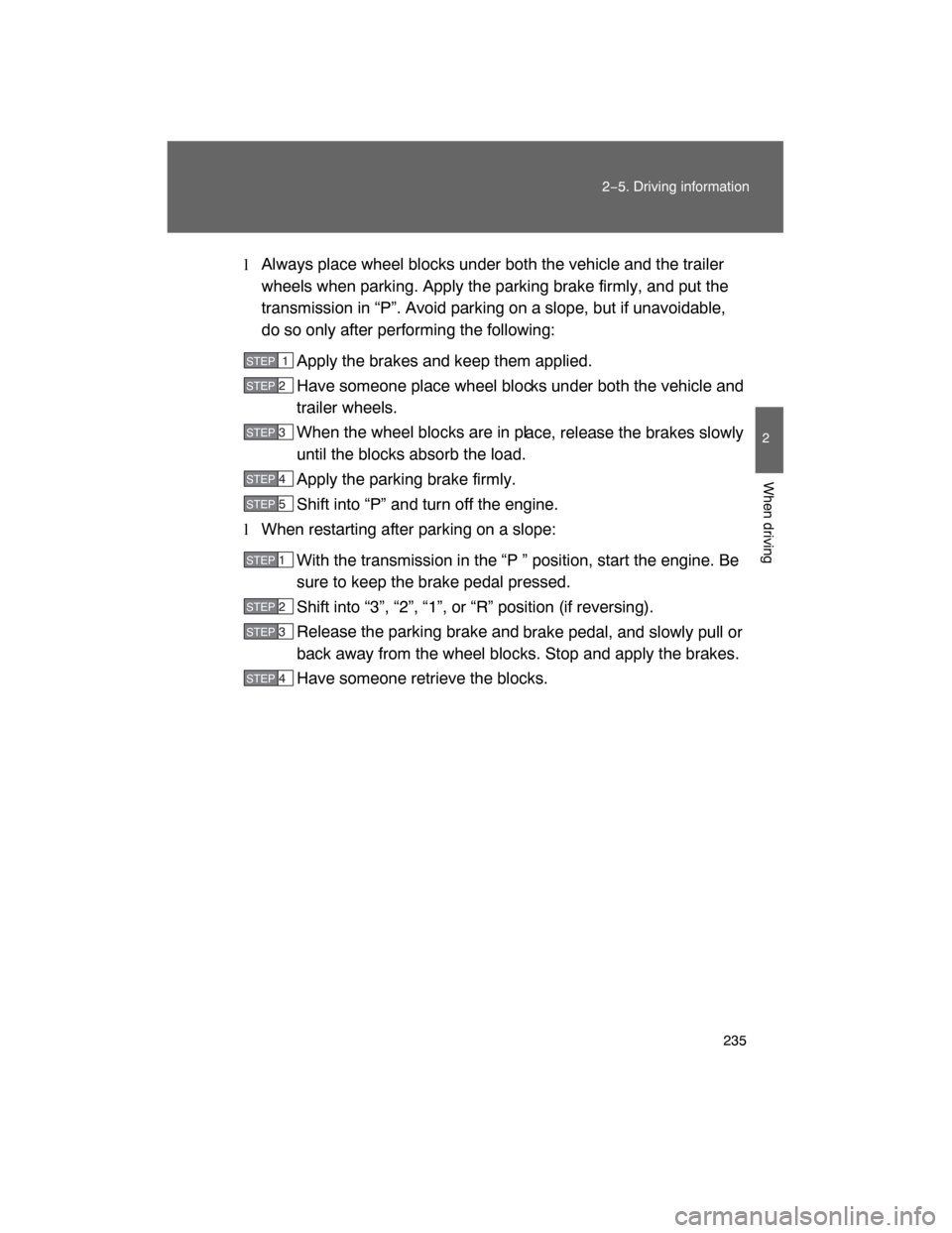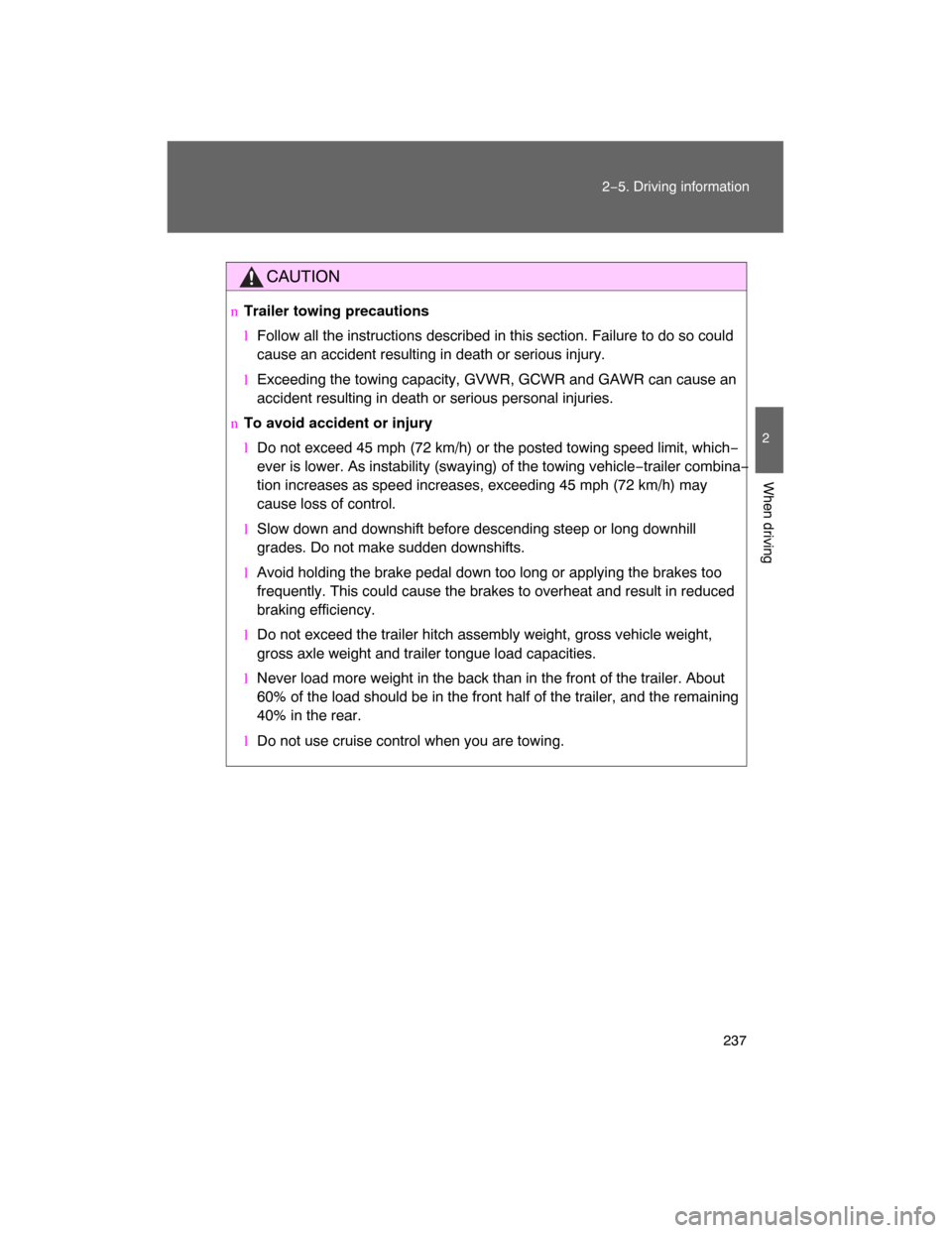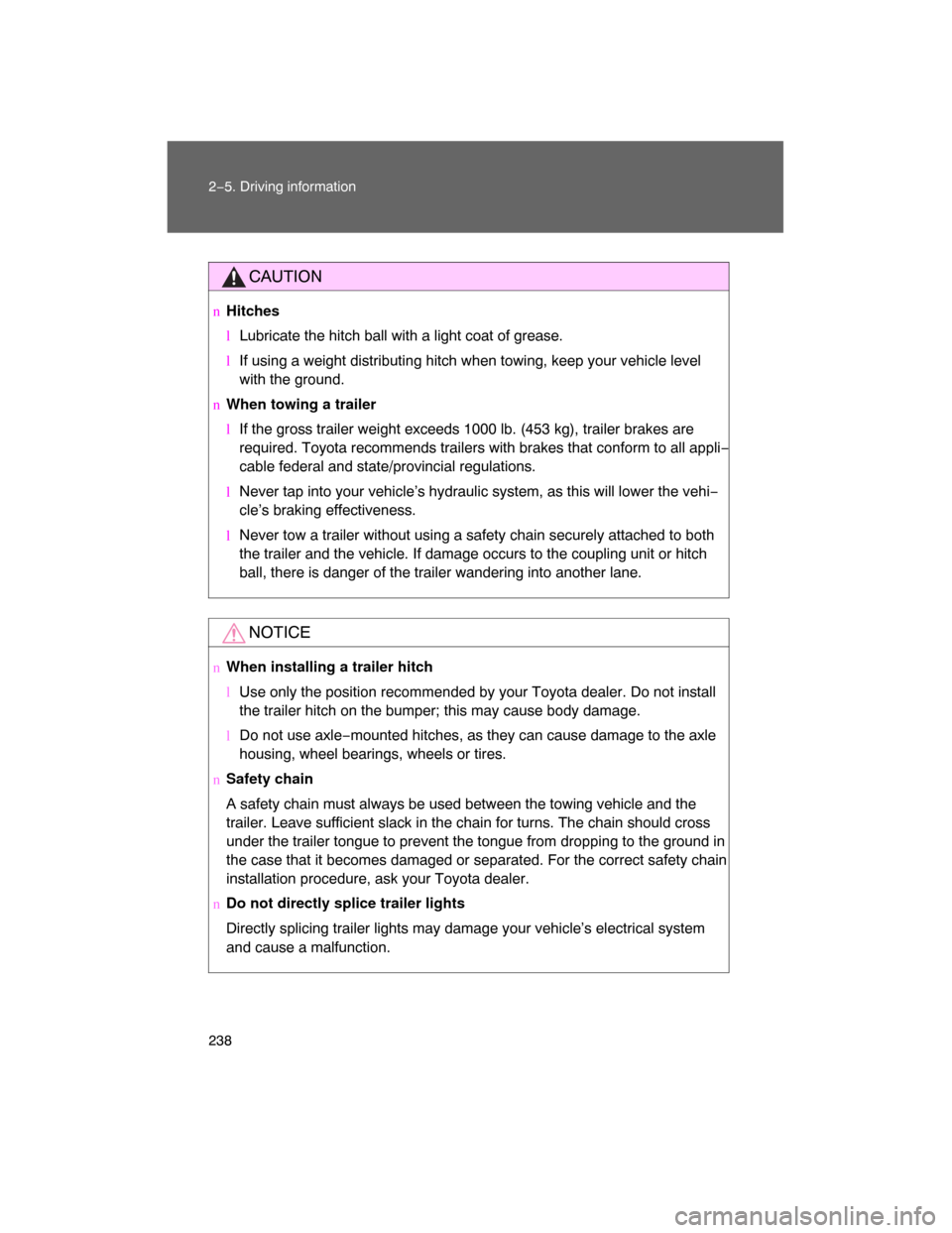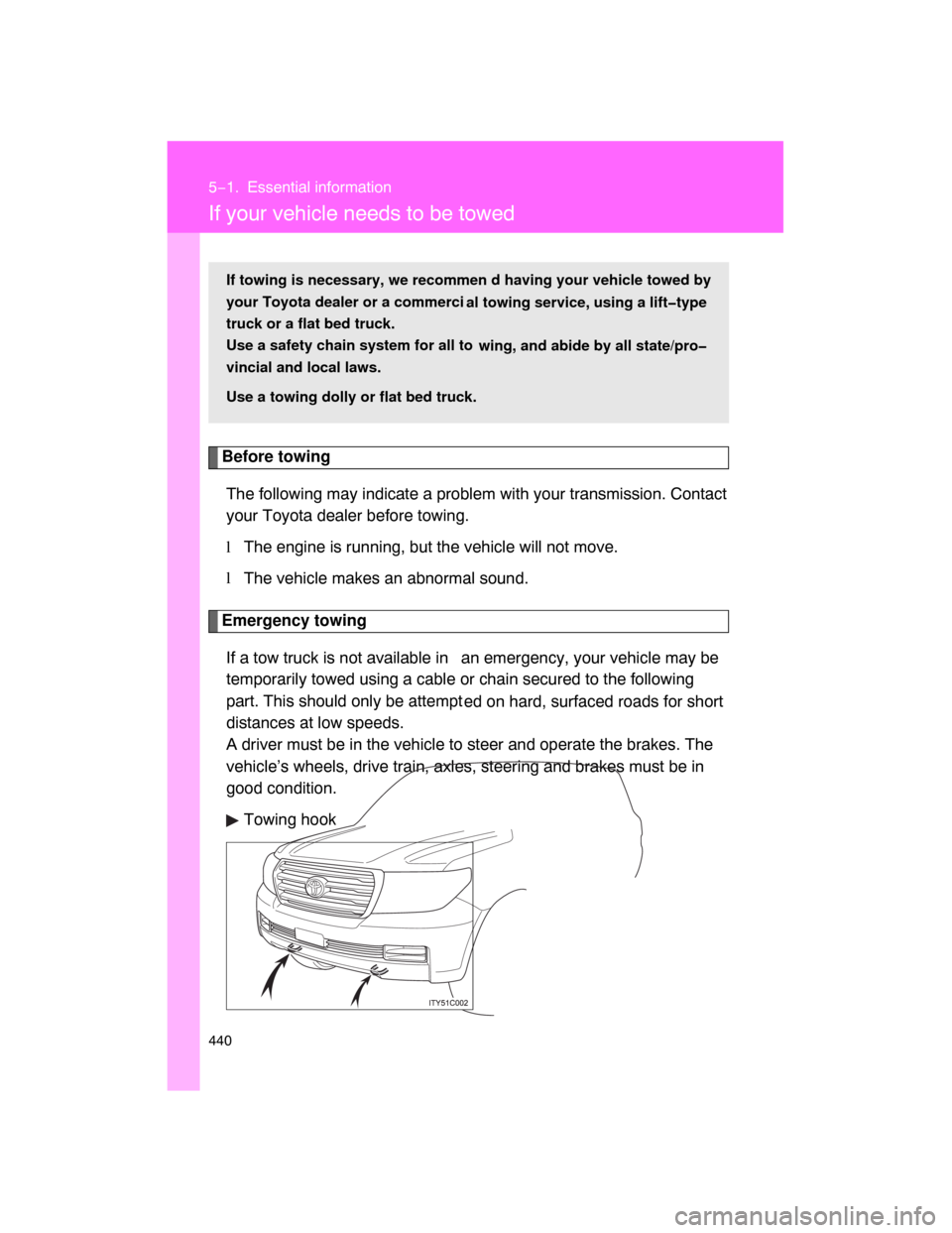Page 233 of 531

235
2−5. Driving information
2
When driving
lAlways place wheel blocks under both the vehicle and the trailer
wheels when parking. Apply the parking brake firmly, and put the
transmission in “P”. Avoid parking on a slope, but if unavoidable,
do so only after performing the following:
Apply the brakes and keep them applied.
Have someone place wheel bloc
ks under both the vehicle and
trailer wheels.
When the wheel blocks are in pl
ace, release the brakes slowly
until the blocks absorb the load.
Apply the parking brake firmly.
Shift into “P” and turn off the engine.
lWhen restarting after parking on a slope:
With the transmission in the “P ” position, start the engine. Be
sure to keep the brake pedal pressed.
Shift into “3”, “2”, “1”, or “R” position (if reversing).
Release the parking brake and
brake pedal, and slowly pull or
back away from the wheel blocks. Stop and apply the brakes.
Have someone retrieve the blocks.
STEP1
STEP 2
STEP 3
STEP 4
STEP 5
STEP 1
STEP 2
STEP 3
STEP 4
Page 235 of 531

237
2−5. Driving information
2
When driving
CAUTION
nTrailer towing precautions
lFollow all the instructions described in this section. Failure to do so could
cause an accident resulting in death or serious injury.
lExceeding the towing capacity, GVWR, GCWR and GAWR can cause an
accident resulting in death or serious personal injuries.
nTo avoid accident or injury
lDo not exceed 45 mph (72 km/h) or the posted towing speed limit, which−
ever is lower. As instability (swaying) of the towing vehicle−trailer combina−
tion increases as speed increases, exceeding 45 mph (72 km/h) may
cause loss of control.
lSlow down and downshift before descending steep or long downhill
grades. Do not make sudden downshifts.
lAvoid holding the brake pedal down too long or applying the brakes too
frequently. This could cause the brakes to overheat and result in reduced
braking efficiency.
lDo not exceed the trailer hitch assembly weight, gross vehicle weight,
gross axle weight and trailer tongue load capacities.
lNever load more weight in the back than in the front of the trailer. About
60% of the load should be in the front half of the trailer, and the remaining
40% in the rear.
l
Do not use cruise control when you are towing.
Page 236 of 531

238 2−5. Driving information
CAUTION
nHitches
lLubricate the hitch ball with a light coat of grease.
lIf using a weight distributing hitch when towing, keep your vehicle level
with the ground.
nWhen towing a trailer
lIf the gross trailer weight exceeds 1000 lb. (453 kg), trailer brakes are
required. Toyota recommends trailers with brakes that conform to all appli−
cable federal and state/provincial regulations.
lNever tap into your vehicle’s hydraulic system, as this will lower the vehi−
cle’s braking effectiveness.
lNever tow a trailer without using a safety chain securely attached to both
the trailer and the vehicle. If damage occurs to the coupling unit or hitch
ball, there is danger of the trailer wandering into another lane.
NOTICE
nWhen installing a trailer hitch
lUse only the position recommended by your Toyota dealer. Do not install
the trailer hitch on the bumper; this may cause body damage.
lDo not use axle−mounted hitches, as they can cause damage to the axle
housing, wheel bearings, wheels or tires.
nSafety chain
A safety chain must always be used between the towing vehicle and the
trailer. Leave sufficient slack in the chain for turns. The chain should cross
under the trailer tongue to prevent the tongue from dropping to the ground in
the case that it becomes damaged or separated. For the correct safety chain
installation procedure, ask your Toyota dealer.
nDo not directly splice trailer lights
Directly splicing trailer lights may damage your vehicle’s electrical system
and cause a malfunction.
Page 363 of 531
368 4−2. Maintenance
Vehicle interior
Items Check points
Accelerator pedal�Moves smoothly (without uneven
pedal effort or catching)?
Automatic transmission “Park”
mechanism�Can the vehicle be hold securely
on an incline with the shift lever in
“P”?
Brake pedal�Moves smoothly?
�Does it have appropriate clear−
ance and correct amount of free
play?
Brakes�Pulls to one side when applied?
�Loss of brake effectiveness?
�Spongy feeling brake pedal?
�Pedal almost touches floor?
Head restraints�Move smoothly and lock
securely?
Indicators/buzzers�Function properly?
Lights�Do all the lights come on?
�Headlights aimed correctly?
Parking brake�Moves smoothly?
�Can hold the vehicle securely on
an incline?
Seat belts�Does the seat belt system oper−
ate smoothly?
�Are the belts undamaged?
Seats�Do the seat controls operate
properly?
Steering wheel
�Moves smoothly?
�Has correct free play?
�No strange noises?
Page 434 of 531

440
5−1. Essential information
If your vehicle needs to be towed
Before towing
The following may indicate a problem with your transmission. Contact
your Toyota dealer before towing.
lThe engine is running, but the vehicle will not move.
l
The vehicle makes an abnormal sound.
Emergency towing
If a tow truck is not available in an emergency, your vehicle may be
temporarily towed using a cable or chain secured to the following
part. This should only be attempt
ed on hard, surfaced roads for short
distances at low speeds.
A driver must be in the vehicle to steer and operate the brakes. The
vehicle’s wheels, drive train, axles, steering and brakes must be in
good condition.
Towing hook
If towing is necessary, we recommen d having your vehicle towed by
your Toyota dealer or a commerci
al towing service, using a lift�type
truck or a flat bed truck.
Use a safety chain system for all to
wing, and abide by all state/pro�
vincial and local laws.
Use a towing dolly or flat bed truck.
Page 435 of 531
5
When trouble arises
441 5−1. Essential information
nEmergency towing procedure
The engine must be in ACCESSORY mode (engine off) or IGNI−
TION ON mode (engine running).
Put the four−wheel drive control switch in “H4”. (The center differen−
tial is unlocked.)
Put the shift lever in “N”.
Release the parking brake.
CAUTION
nWhile towing
lUse extreme caution when towing the vehicle.
Avoid sudden starts or erratic driving maneuvers which place excessive
stress on the emergency towing hook and the cable or chain.
lIf the engine is not running, the power assist for the brakes and steering
will not function, making steering and braking more difficult.
NOTICE
nTo prevent causing serious damage to the transmission
lNever tow this vehicle wheels on the ground.
l
Use only the front emergency towing hooks or towing eyelets (depending
on vehicles) when towing your vehicle.
STEP1
STEP 2
STEP 3
STEP 4
Page 451 of 531
5
When trouble arises
457 5−2. Steps to take in an emergency
CAUTION
n If the tire pressure warning light comes on
Be sure to observe the following precautions. Failure to do so could
cause loss of vehicle control and result in death or serious injury.
lStop your vehicle in a safe place as soon as possible. Adjust the tire
inflation pressure immediately.
lIf the tire pressure warning light comes on even after tire inflation pres−
sure adjustment, it is probable that you have a flat tire. Check the tires.
If the tire is flat, change to the spare tire and have the flat tire repaired
by the nearest Toyota dealer.
lAvoid abrupt maneuvering and braking. If the vehicle tires deteriorate,
you could lose control of the steering wheel or the brakes.
n If a blowout or sudden air loss should occur
The tire pressure warning system may not activate immediately.
Page 476 of 531
482 5−2. Steps to take in an emergency
Changing “ENGINE START STOP” switch modes and starting the
engine
Shift the shift lever to “P” and apply the brakes.
Touch the Toyota emblem side of
the electronic key to the
“ENGINE START STOP” switch.
An alarm will sound to indicate
that the start function cannot
detect the electronic key that is
touched to the “ENGINE START
STOP” switch if any of the doors
is opened while the key is
touched to the switch.
To change “ENGINE START STOP” switch modes: Within 10
seconds of the buzzer soundin
g, release the brake pedal and
press the “ENGINE START STOP” switch. Modes can be
changed each time the sw
itch is pressed. ( P. 149)
To start the engine: Press the “ENGINE START STOP” switch
within 10 seconds after the buz
zer sounds, keeping the brake
pedal depressed.
If the “ENGINE START STOP” swit
ch cannot be operated, contact
your Toyota dealer.
STEP1
STEP 2
STEP 3